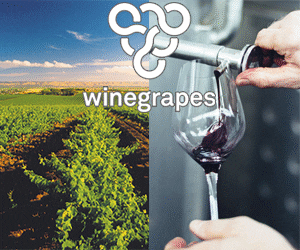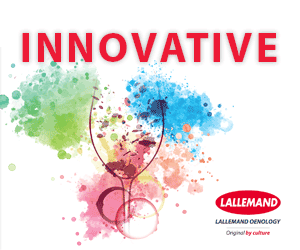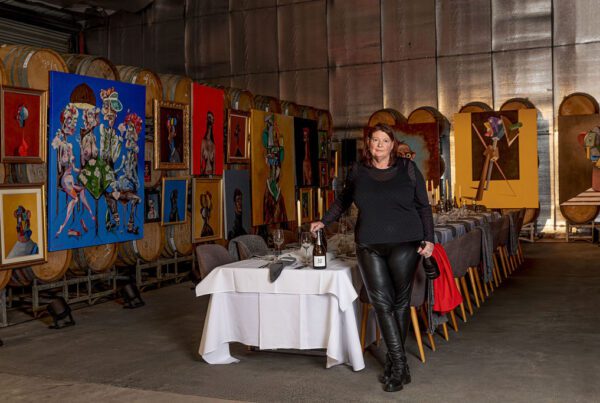
What are you thinking? That question was at the core of a special 18-page feature in WBM – Australia’s Wine Business Magazine, about the future of wine. Some of the wine industry’s best thinkers had their say. Rachel Triggs is an advisory board member of Australian Women in Wine. This is what she thinks.
The Australian wine industry isn’t short on ideas – it’s overflowing with them. Brilliant minds across the sector are constantly pushing boundaries, innovating in viticulture, sustainability, branding and global strategy. But the problem isn’t ideation; it’s execution. Too many of our leaders seem more passionate about process than purpose, more fluent in governance jargon than in the language of vineyards, vintages, varietals and value. The big ideas are out there – what’s missing is the leadership to act on them. It’s hard to feel confident in a future being shaped by people who don’t appear to love wine – or even particularly like it.
The 2023 Future Leaders were a shot of pure oxygen – sharp, brave and refreshingly unafraid to challenge business as usual. Their 2023 Thought Leadership publication brimmed with bold ideas and a clear-eyed vision for the future. You have to wonder how many contributors to the One Grape and Wine Sector Plan read it cover to cover – because if they had, we might’ve ended up with something far less cautious and far more compelling. If the industry wants real change, it’s time to stop sidelining its brightest minds and start letting them lead.
This year marks the tenth anniversary of Australian Women in Wine – a milestone that rightly celebrates the contribution of women across all corners of the industry. It’s a moment to recognise the talent, leadership and resilience that have helped shape Australian wine, often in the face of systemic barriers. But it’s also a reminder of how far we still have to go in diversifying the voices shaping our future. Greater equality isn’t just about fairness – it’s about unlocking the full spectrum of ideas, perspectives and creative thinking our industry needs to thrive. Big ideas flourish in environments where different experiences are welcomed, not sidelined. If we want bold, future-focused leadership, we need to ensure the table is set for a more diverse range of voices to be heard – and backed.
To be fair, the current composition of the Wine Australia Board is diverse, and that should be acknowledged. That’s a credit to the government and the independent selection panel process. But why on earth isn’t it operating with a full complement? Under section 13 of the Wine Australia Act, the board is to consist of a chair and at least five, and not more than seven, other directors. Yet right now, it has just five. Given the scale and complexity of its statutory remit, that’s frankly ludicrous.
There are unquestionably good people around the table – dedicated, capable and doing their best – but let’s not pretend that goodwill can substitute for capacity. This is a statutory body responsible for everything from export regulations, label integrity and food standards, to trade negotiations, giving effect to existing trade agreements, brand strategy and the stewardship of world-leading grape and wine research. Most R&D corporations – and certainly most statutory authorities – would be staggered by that breadth. And yet, we continue to navigate it all with a board that wouldn’t even fill a regional tasting panel.
Then there’s the Australian Wine Research Institute (AWRI) – the crown jewel of our industry and the quiet achiever behind our global reputation. Undermine it at your peril. Failing to protect and fund the AWRI isn’t just short-sighted – it’s generationally reckless. If we want longevity – and not just in wines built to survive a trip to Tesco – we need to invest in the intellectual horsepower that keeps us globally competitive.
Having spent years travelling the world representing the Australian wine sector in bilateral and multilateral trade negotiations and industry delegations, I’ve seen just how much respect Australia commands on the international stage. We have long been the envy of our competitors – not only for the quality and diversity of our wines, but for the coherence, credibility and scientific strength that underpin our industry. The AWRI has been central to that standing. Its technical expertise and global reputation for rigour have opened doors, built trust and underpinned countless trade discussions. In many rooms, it has been the differentiator – the reason partners are willing to engage with Australia on more sophisticated terms. It’s not just a research institute; it’s a strategic asset. And in a global market that is becoming increasingly data- driven, quality-conscious and science-led, we would be foolish not to protect and elevate it.
This brings me, less poetically, to levies. Why aren’t we having the grown-up conversations that should have started years ago? CPI indexing was never built into the model, on the assumption that grape and wine prices would steadily increase. They haven’t – so why hasn’t the legislation been updated? If industry genuinely supports Wine Australia’s continued existence, this is a no-brainer. If we’re crying poor on marketing funds (and navel gazing about who should contribute what), why aren’t we restructuring the Wine Export Charge and addressing the levy issue head-on? Why aren’t we implementing an ad valorum rather than a volumetric calculation for both the Grape Research Levy and the Wine Grape Levy? Or, at the very least, questioning whether the current hypothecation of the Wine Grape Levy still makes sense? Flexibility between R&D and marketing spend shouldn’t be treated as radical – it should be the default. Let’s get the revenue mix right before we go reinventing the wheel (or worse – getting a consultant to). If the levy structure has you scratching your head, you’re in good company. Happy to talk it through over lunch – legislative references go down surprisingly well with a decent glass of Riesling.
And while we’re on the topic of grown-up conversations, let’s talk about the Concerned Elders. These are not has-beens reminiscing about the good old days – they are the brains trust of our industry. They’ve seen markets rise, crash, adapt and evolve. They’ve negotiated trade deals, built brands, driven research and made the tough calls that many today would rather outsource. To dismiss them as out of touch is not only lazy – it’s insulting. These people are dedicating their time and energy, unpaid, to move the dial on the issues that matter most. And frankly, they’re tired of being ignored by those who confuse fresh-faced enthusiasm with fully formed strategy. We’d do well to listen.
Naturally, production costs, price point and profitability remain fundamental – core indicators of commercial performance. Understanding demand, responding to shifting consumer preferences, and navigating the broader landscape of market dynamics and geopolitical trends are all essential. These factors shape the conditions in which the industry must operate, and no serious strategy can ignore them. But let’s not pretend wine begins and ends with the balance sheet. Wine is not a homogenous product – it’s rooted in history, shaped by culture, and deeply connected to people and place. It carries narrative, emotion, and yes, even a bit of romance. That’s what sets it apart. We need leaders who understand both sides of the equation – who can read a P&L but also instinctively get what wine means. Big ideas come from people who believe in wine not just as a product, but as a story worth telling. And if we want the world to fall in love with Australian wine, we need to be led by people who already have.
We’re long overdue in viewing the industry through a dual lens: first, the Australian branded wine market – premium, place-driven and emotionally resonant; and second, wine as a commercially traded global product – shelf-ready, margin-critical and ruthlessly transactional. Confuse the two, and you’ll find yourself spending a fortune talking terroir to a supermarket buyer who only wants the FOB price and sugar levels.
Speaking of sugar, we need to realise that wine will increasingly be taxed volumetrically based on alcohol concentration – and that this shift is already hurting us. Just look at the UK, where recent tax changes have had a crippling effect on parts of the Australian portfolio. And this isn’t happening in isolation. The World Health Organization’s Global Alcohol Action Plan 2022-2030 is fuelling a coordinated international push to reduce harmful alcohol use, with governments being encouraged to adopt stronger pricing and tax measures based on alcohol content. If we don’t start investing in both viticulture and winemaking practices that support ripening and style at naturally lower alcohol levels – and I mean actually funding the science, not just talking about it at conferences – we’ll be priced out of key markets.
Which brings us to the mid-strength category – an area we’re failing to define (including from traditional wine which is crucial), let alone lead. Right now, consumers can’t tell if a 9.5 percent wine is a happy accident or a sad compromise. We need a clear, distinctive mid-strength segment – proudly positioned, not meekly marketed. This is our opportunity to shape a new consumption space, but it requires imagination, intent and branding that wasn’t designed by a hungover intern. Spoiler alert: slapping “wine product of Australia” on a mid- strength in Tokyo or “partially dealcoholised wine” on a label in London isn’t exactly going to have sommeliers swooning. And if we don’t get ahead of the wildly inconsistent global labelling rules, we’ll all be nursing regulatory headaches at 9am Vinexpo breakfasts – without the excuse of the afterparty.
Regulation has long been a strength of the Australian wine industry – robust, credible and internationally respected. But it’s at real risk of being left in the dark ages. Why are we still conducting paper-based label integrity audits in 2025? We should have ampelographers in vineyards verifying what’s actually planted, not auditors rummaging through filing cabinets in search of last year’s vintage declarations. If we’re serious about integrity, traceability and sustainability, digitalisation shouldn’t be a long-term ambition – it should already be the baseline.
The wine industry’s been tiptoeing around structural reform for years – the concept isn’t getting any better with age. Red meat, pork, horticulture and dairy have already merged their peak bodies and RDCs – why are we still operating under a system where everyone has to check with someone else’s mum before making a move? Folding Australian Grape & Wine and Wine Australia into one modern entity makes strategic sense. Of course, the regulatory function would need to be lifted out into a separate body – a straightforward copy-and-paste of Part VIA of the Wine Australia Act, run on a cost-recovery basis through export fees. Yes, there are legislative details to address, but they’re well within reach of a determined industry ready to modernise. Crucially, this reform would give the industry real ownership of its peak body, create proper distance from government, and remove the comfort blanket Wine Australia sometimes wraps itself in when the advocacy conversation gets a little too robust.
Let’s also be real about how the world sees us. When the global imagination conjures Australia, it’s often bushfires, high-vis photo ops and mildly bewildered (and often smouldering) wildlife. That’s not exactly the mood you want when presenting a premium wine portfolio. If we want to elevate Australian wine globally, we need to help elevate Australia itself. That requires bold, cross-sector collaboration – working with the private sector, ABC, Screen Australia, Tourism Australia, the Australian Tourism Industry Council, DFAT, Austrade, the Australian Fashion Council, our chefs and restaurateurs – anyone and everyone shaping the national narrative. Wine should be part of that bigger story, not left to carry it alone.
It’s time we stopped letting dispassionate primary produce experts treat wine like it’s just another tonne of wheat. A one-size-fits-all strategy might work for red meat, but wine is a different beast altogether – a sophisticated, elaborately transformed luxury product that demands nuance. You can’t spreadsheet your way to provenance, personality or Pinot. Wine is grown and made on the strength of site, soul and story – and it deserves a strategy as refined as the product itself.
But ultimately – and here’s where I drop the pretence of diplomacy – the industry needs to be led by people who love wine. Not people who love a gin and tonic and a Starbucks frappe at the airport. We need passion. We need depth. We need leaders who feel the seasons in their bones – not just overhear them between sessions at a regional forum while balancing an over- percolated coffee and a mini quiche.
Because without that, all the strategic reviews, structural reform, levy tinkering and export strategy in the world won’t save us.
It’s wine. It’s personal. And it’s high time we started acting like it.
• This article first appeared in the May-June 2025 issue of WBM – Australia’s Wine Business Magazine.













Recent Comments